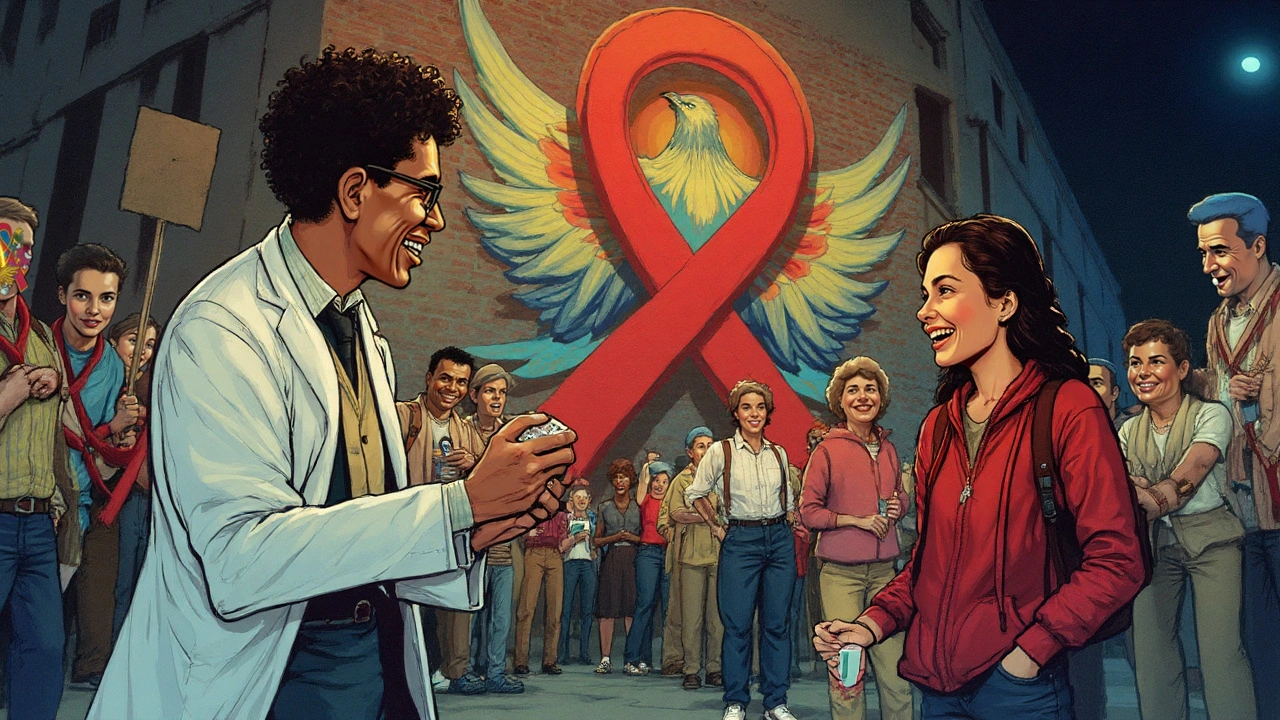Human Immunodeficiency Virus (HIV) is a retrovirus that attacks CD4+ T cells, weakening the immune system and eventually causing acquired immunodeficiency syndrome (AIDS). The story of HIV reads like a medical thriller: frantic early warnings, controversial politics, rapid scientific breakthroughs, and today’s life‑saving drug regimens. Understanding this timeline helps patients, clinicians, and anyone curious about public‑health policy see why yesterday’s panic turned into today’s manageable chronic condition.
Early Clues and the First Identifications
In the early 1980s, physicians in Los Angeles reported a surge of rare cancers and opportunistic infections among young gay men. The pattern soon appeared in New York and France. By 1983, French virologist Luc Montagnier isolated a new retrovirus, initially called LAV (Lymphadenopathy‑Associated Virus). In 1984, American researcher Robert Gallo identified what he termed HTLV‑III. The two discoveries were merged in 1986, giving the world the name Human Immunodeficiency Virus.
From Virus to Disease: Defining AIDS
The Centers for Disease Control and Prevention (CDC) officially coined the term AIDS (Acquired Immunodeficiency Syndrome) in 1982, describing the clinical syndrome caused by HIV. AIDS is defined by a CD4 count under 200 cells/mm³ or the presence of opportunistic infections like Pneumocystis pneumonia. This clinical definition gave doctors a concrete way to track the epidemic and sparked global surveillance.
The First Antiretroviral: AZT
In 1985, the FDA approved zidovudine (AZT) - the first drug shown to inhibit HIV replication in vitro. AZT is a nucleoside reverse transcriptase inhibitor (NRTI). It works by mimicking the natural nucleosides that the viral reverse transcriptase enzyme uses to copy RNA into DNA, causing premature chain termination. While AZT extended survival for some patients, toxicity (anemia, neutropenia) limited long‑term use.
Building Combination Therapy: The Birth of HAART
By the early 1990s, researchers realized that HIV mutates rapidly, rendering single‑drug regimens ineffective. In 1995, protease inhibitors (PIs) such as saquinavir entered the market, targeting the viral protease enzyme needed to cleave viral polyproteins. The next year, clinicians combined two NRTIs with a PI - a strategy called Highly Active Antiretroviral Therapy (HAART). HAART slashed viral loads from millions of copies per milliliter to undetectable levels and turned AIDS from a death sentence into a manageable chronic disease.
Refining the Arsenal: Integrase Inhibitors and Beyond
While NRTIs and PIs saved millions, they came with metabolic side‑effects. The early 2000s saw the introduction of integrase strand transfer inhibitors (INSTIs) such as raltegravir. INSTIs block the enzyme HIV uses to insert its DNA into the host genome - a critical step the virus cannot bypass. Today, first‑line regimens often combine two NRTIs with an INSTI, offering high potency, low pill burden, and fewer side‑effects.
Monitoring Progress: Viral Load and CD4 Testing
Accurate monitoring is essential. Viral load testing quantifies the number of HIV RNA copies per milliliter of blood, guiding treatment decisions. Advances in polymerase chain reaction (PCR) technology reduced detection limits to <10 copies/mL by the 2010s. Meanwhile, routine CD4 count measurements still inform clinicians about immune recovery and opportunistic infection risk.

Global Coordination: WHO and Public‑Health Policies
The World Health Organization (WHO) issued its first antiretroviral guidelines in 1996, recommending treatment for patients with CD4<200. In 2015, WHO adopted the "Treat‑All" policy, urging immediate therapy regardless of CD4 count. This shift, backed by massive funding from the Global Fund and PEPFAR, accelerated treatment coverage in low‑ and middle‑income countries, pushing worldwide viral suppression rates above 70% by 2024.
Modern Treatment Landscape (2020‑2025)
Current first‑line regimens, such as Bictegravir/Emtricitabine/Tenofovir alafenamide (BIC/FTC/TAF), combine an INSTI with two NRTIs in a single tablet taken once daily. The regimen boasts >99% suppression rates, minimal renal toxicity, and excellent adherence profiles. Long‑acting injectable formulations-cabotegravir plus rilpivirine-offer dosing every two months, a game‑changer for patients struggling with daily pills.
Emerging Frontiers: Cure Research and Vaccines
While antiretrovirals control the virus, a true cure remains elusive. Researchers explore two main strategies: "kick‑and‑kill" approaches that reactivate latent reservoirs followed by immune clearance, and gene‑editing tools like CRISPR to excise proviral DNA. Parallel efforts aim to develop a preventative vaccine. The most advanced candidate,Mosaico, entered PhaseIII trials in 2023, showing modest efficacy but sparking hope for a multi‑component vaccine that could finally block infection.
Related Concepts and Connected Topics
Understanding HIV’s past sheds light on several interconnected areas:
- Stigma and discrimination-social barriers that still affect testing and treatment uptake.
- Pre‑exposure prophylaxis (PrEP)-daily oral tenofovir/emtricitabine that reduces acquisition risk by >90%.
- Post‑exposure prophylaxis (PEP)-short‑term therapy after potential exposure.
- HIV‑associated neurocognitive disorder (HAND)-cognitive impacts despite viral suppression.
Comparison of Major Treatment Eras
| Era | Primary Drugs | Mechanism | Typical Suppression Rate | Side‑Effect Profile |
|---|---|---|---|---|
| Monotherapy (mid‑1980s) | AZT | NRTI - reverse transcriptase inhibition | ~30% | High (anemia, neutropenia) |
| HAART (mid‑1990s) | 2NRTIs + 1PI | Multiple enzymatic blocks | ~70‑80% | Metabolic (lipids, insulin resistance) |
| Modern INSTI‑based (2020‑present) | 1INSTI + 2NRTIs (single‑tablet) | Integrase inhibition + reverse transcriptase | >99% | Low (rare renal, bone effects) |
What the Future Holds
Looking ahead, three trends will shape HIV care:
- Long‑acting formulations - injectable or implantable devices delivering drugs for months.
- Broad‑line combination pills that incorporate an INSTI, NRTI, and a novel entry inhibitor, further simplifying regimens.
- Potential functional cures from gene‑editing or therapeutic vaccines, which could reduce or eliminate the need for lifelong therapy.
Each breakthrough builds on the HIV history of relentless research, community advocacy, and global cooperation.

Frequently Asked Questions
When was HIV first discovered?
The virus was independently identified in 1983 by French researcher Luc Montagnier and in 1984 by American scientist Robert Gallo. Their findings were merged in 1986, giving the name Human Immunodeficiency Virus.
What is the difference between HIV and AIDS?
HIV is the virus that infects the immune system. AIDS is the clinical syndrome that develops when HIV has caused severe immune damage, typically defined by a CD4 count below 200 cells/mm³ or the presence of opportunistic infections.
Why are combination therapies more effective than single drugs?
HIV mutates quickly. Using drugs that target different steps-reverse transcription, protease activity, and integrase-makes it far harder for the virus to develop resistance, leading to higher suppression rates and longer durability.
What are the current first‑line HIV drugs in 2025?
Most guidelines recommend a single‑tablet regimen of bictegravir/emtricitabine/tenofovir alafenamide (BIC/FTC/TAF) for treatment‑naïve adults. Alternatives include dolutegravir/lamivudine/tenofovir disoproxil fumarate and the long‑acting injectable cabotegravir + rilpivirine.
How is viral load measured and why does it matter?
Viral load is quantified using polymerase chain reaction (PCR) assays that detect HIV RNA copies per milliliter of blood. A sustained undetectable viral load (<50 copies/mL) predicts near‑zero risk of transmission and is the goal of antiretroviral therapy.
Can HIV be cured?
A complete cure-eliminating all proviral DNA-has not yet been achieved. However, a few cases of functional cure (viral remission without therapy) have been reported after stem‑cell transplants. Ongoing research into latency‑reversing agents, gene editing, and therapeutic vaccines aims to make a cure a reality.
What role do global organizations play in HIV treatment access?
The WHO sets treatment guidelines, while programs like PEPFAR, the Global Fund, and UNAIDS fund drug procurement, training, and testing in low‑resource settings. Their coordinated efforts have increased worldwide viral suppression from 7% in 2000 to over 70% in 2024.



Singh Bhinder
September 25, 2025 AT 00:20Wow, the timeline of HIV treatment is mind‑blowing. It’s crazy how we went from a single drug with nasty side‑effects to single‑tablet combos that people can take for life. I wonder how the early researchers dealt with the stigma back then, and what lessons we can pull for other emerging infections.
Kelly Diglio
September 27, 2025 AT 07:54I appreciate the thorough overview; it really underscores how collaborative science saved millions. The shift from monotherapy to HAART was a watershed moment, and the data you presented help illustrate why adherence matters so much today.
Carmelita Smith
September 29, 2025 AT 01:34Great summary! 😊
Liam Davis
October 1, 2025 AT 03:34The AZT story is a classic case of early promise hampered by toxicity; anemia, neutropenia, and mitochondrial dysfunction were significant hurdles. Clinical trials showed modest survival benefits, yet the drug’s pharmacokinetics forced high dosing schedules. Over‑time, dose‑reduction strategies and combination regimens mitigated many adverse events, but the experience taught us the necessity of balancing efficacy with safety.
Arlene January
October 2, 2025 AT 12:54Exactly! And now we’ve got regimens you can take with dinner-makes a huge difference for people juggling work and life.
Kaitlyn Duran
October 4, 2025 AT 20:27I'm really curious about those long‑acting injectables you mentioned. If patients only need a shot every few months, that could solve adherence problems for a lot of folks. Do we have any data on side‑effects compared to daily pills?
Terri DeLuca-MacMahon
October 6, 2025 AT 08:34Good point! 🌟 The Phase III trials for cabotegravir‑rilpivirine showed comparable viral suppression to daily tablets, with injection site pain being the most common complaint. Overall, the safety profile looks promising and could be a game‑changer for many communities. 🙌
gary kennemer
October 9, 2025 AT 06:00The evolution of HIV therapy reads like a philosophical journey from desperation to hope. In the early 1980s, clinicians faced a deadly unknown, forced to confront mortality without weapons. The isolation of the virus by Montagnier and Gallo provided a tangible target, turning abstract fear into a scientific challenge. AZT, though imperfect, represented humanity's first attempt to wield chemical tools against a viral foe, embodying the principle that any intervention, however crude, can shift the odds.
When HAART arrived, it was a triumph of systems thinking: combining agents that attacked multiple stages of the viral life cycle, thereby limiting resistance. This synergy reflected a deeper understanding that complex problems require multifaceted solutions. The subsequent rise of integrase inhibitors further refined this approach, offering higher potency with fewer metabolic side‑effects, showing that progress is not linear but iterative.
Monitoring technologies, such as PCR‑based viral load assays, transformed clinical practice, turning invisible viral particles into quantifiable metrics. This feedback loop empowered patients and providers alike, fostering a sense of agency. Moreover, the global scale‑up of treatment programs illustrated that public health is as much about logistics and policy as it is about science.
Looking ahead, the field confronts new philosophical questions: Will long‑acting formulations alter the patient‑provider relationship? Can gene‑editing truly erase the viral reservoir, or will it raise ethical dilemmas about human modification? The narrative of HIV therapy is thus a living case study in how medicine, society, and technology co‑evolve.
Payton Haynes
October 11, 2025 AT 08:00All this progress sounds great, but think about who profits. Big pharma pushed AZT fast, making huge bucks while patients suffered side‑effects. The same pattern repeats with every new drug; we’re just paying for marketing hype.
Earlene Kalman
October 12, 2025 AT 11:47Typical paranoid rant. The data are clear, not every new pill is a cash grab.
Brian Skehan
October 15, 2025 AT 00:54You all ignore the hidden agendas. The vaccine pilots are just a cover for microchip implants. The real cure is being suppressed.
Andrew J. Zak
October 15, 2025 AT 23:07Maybe you’ve read too many conspiracy blogs. HIV research follows rigorous peer review, not secret plots.
Dominique Watson
October 18, 2025 AT 06:40It is worth noting that the United Kingdom’s early adoption of needle‑exchange programs outperformed many US cities, highlighting the importance of proactive public health policies over political grandstanding.
Mia Michaelsen
October 18, 2025 AT 20:34Actually, the US has been a leader in antiretroviral development; the claim about the UK is a selective reading of the data.
Kat Mudd
October 20, 2025 AT 14:14Honestly, this whole hype about modern therapy is just a smokescreen for the fact that we’re still losing people to AIDS in under‑served regions. The glossy tables and optimistic forecasts ignore the brutal reality that many countries lack basic diagnostics, let alone the ability to keep patients on lifelong medication. When the big conferences celebrate 99% suppression rates, they’re talking about a tiny fraction of the global infected population. The rest are left with broken supply chains, corrupt officials, and stigma that keeps them from even getting tested. While researchers brag about integrase inhibitors, the world’s poor are still battling opportunistic infections that could have been prevented with simple prophylaxis. The narrative is skewed, focusing on high‑tech solutions while ignoring the need for basic healthcare infrastructure, education, and political will. Until that gap is closed, the percentages you quote are meaningless, merely a trophy for the privileged few.
Pradeep kumar
October 21, 2025 AT 09:40Indeed, the disparities are stark, but there’s reason for optimism. Leveraging implementation science and community‑led models can accelerate ART rollout, while novel long‑acting formulations promise adherence gains even in resource‑limited settings. By aligning stakeholder incentives and scaling task‑shifting, we can bridge the gap without sacrificing efficacy.
James Waltrip
October 23, 2025 AT 11:40One must appreciate the epistemic elegance of the HAART paradigm, wherein the confluence of pharmacodynamics, virology, and patient adherence coalesce into a veritable symphony of therapeutic triumph. Yet, let us not be lulled into complacency; the frontier of eradication beckons, demanding our most perspicacious intellects.
Chinwendu Managwu
October 24, 2025 AT 04:20Sure, but who’s really benefitting from that “symphony”? 🙄
Kevin Napier
October 25, 2025 AT 13:40Let’s keep the conversation constructive-there’s a lot we can learn from each other, and supporting one another is how we’ll keep moving forward.
Sherine Mary
October 26, 2025 AT 11:54Optimism is nice, but it masks the fact that many patients still feel isolated and hopeless despite the advances.